Mridula Nilesh Joshi1, Nilesh Vaman Joshi2, Anushri D. Kulkarni1
1Department of Prosthodontics, Bharti Vidyapeeth University’s Dental College and Hospital, Navi Mumbai, Maharashtra, India
2Department of Periodontology, Bharti Vidyapeeth University’s Dental College and Hospital, Navi Mumbai, Maharashtra, India
Correspondence to: Mridula Nilesh Joshi, Department of Prosthodontics, Bharti Vidyapeeth University’s Dental College and Hospital, Navi Mumbai, Maharashtra, India.
| Email: |  |
Copyright © 2014 Scientific & Academic Publishing. All Rights Reserved.
Abstract
Purpose: The purpose of this study was to determine the characteristics of an esthetic smile. Materials and methods: Smiles of 60 subjects (males & females) were analyzed, considering criteria such as smile type (high, average or low), parallelism of upper incisal curvature to the lower lip, contact of upper incisal curvature with lower lip and number of teeth displayed in the smile. Results: The result showed 41.6% (25 subjects) showed average smile type and average smile type showed a statistically significant occurrence in females (z = 2.44). 63.3% (38 subjects) showed parallelism of incisal curvature with lower lip and this was significantly higher in females (z = 5.02) while reverse curvature was highly significant in males. The upper incisor curvature touched the lower lip in 41.66% (25 subjects). Females showed more of touching type of incisal curvature (z = 5.85) while males showed more of an incisal curvature that was not touching the lower lip (z = 2.81). Six anteriors & first premolars were exposed in 55% (33) cases. Differences in males & females in this group were not statistically significant. Conclusion: The result showed that the characters of an esthetic smile are an average smile line, therefore only part of interdental gingiva seen, incisal curvature of maxillary anterior teeth parallel to the lower lip curvature, upper incisal curvature slightly touching the lower lip, first or second premolars also seen in smile and a harmonious midline. All the above criteria were found more in females than males.
Keywords:
Social media, Emotion mashup, Multimedia
Cite this paper: Mridula Nilesh Joshi, Nilesh Vaman Joshi, Anushri D. Kulkarni, Study to Evaluate Dentofacial Factors Governing an Esthetic Smile, International Journal of Stomatological Research, Vol. 3 No. 1, 2014, pp. 1-6. doi: 10.5923/j.ijsr.20140301.01.
1. Introduction
A person’s dental and facial appearance is important not only in the role that attractiveness plays to others but also in one’s self concept. Perception of appearance, particularly of the face, affects mental health and social behavior. The increased emphasis of facial appearance in our society demands for esthetic dental restorations.Smile is a complex gesture, wherein the lips, teeth and dark spaces – all blend together to create a harmonious effect. [9, 11]Teeth exposed in smiling are a VITAL part of the anatomy of the smile. This study was undertaken to know the characteristics of an esthetic smile.There are many studies regarding esthetic and other factors in a smile, the important ones being listed below:Vig RG and Brundo GC (1978) [22] studied the variability of sex, race and lip length on teeth display. Tjan A. H. et al (1984) [21] did a comparative analysis of characteristic dental features of esthetic smiles, also mentioned by Frush and Fisher [5] and Margolis M J [10].Husley C M [8] evaluated the lip-teeth relationship present in a smile. Yoon et al (1992) [3] studied the attractiveness of smile under different heads.Also Sarver D M studied the esthetic factor of smile as pertaining to the display of gingival [18, 19, 20].Apart from the esthetic characters, various factors affecting smile were also studied as, effect of age on the smile, by Choi et al (1995)3 and Goldstein [7]; effect of oral conditions on smile by Ko et al (1993) [3]. Morley J [13, 14] also described the characters that differentiate a youthful and aged smile and the role of cosmetic dentistry to restore a youthful smile. Kim et al (1995) [3] studied the correlation between personality factors & smile.M Fradeani (2006) [6] evaluated dentolabial characters like incisal edge positions, smile width, incisal curve and profile as a part of esthetic comprehensive analysis and found that all these characters play an important role.Al Habahbeh R, Al- Shaammount R,Al- Jabrah O,Al- Omari F. (2009) [2] studied the effect of gender on tooth display in the anterior region during rest and smiling. Mohan Bhubneswaran. (2010) [12] thoroughly evaluated principles of smile designing, also study done by Abdul Haq A Suliman and Rawhi H Al Qaisi (2009) [1] discusses considerations of beautiful smile.Sachdeva K, Singla A, Mahajan V,Jaj HS, Negi A (2012) [17], evaluated lip length and thickness and buccal corridor and correlation of lip length and incisal display with age.But, inspite of the available data, the fact remains that – evaluating smiles would always be SUBJECTIVE.Thus the purpose of this study was to evaluate the factors of smile which contributed to an esthetic result.
2. Materials and Methods
Smile analysis of 60 subjects (both males and females) who were randomly selected was done. Full face smiling photographs were taken.Exclusion criteria were:− Previous orthodontic / restorative treatment of anteriors.− Crowding / spacing / malalignment of teeth.− Missing teeth, − Oral deformity.Smile was analyzed under the following four heads:− Smile type (high, average or low).− Parallelism of upper incisal curvature to the lower lip (parallel, straight or reverse).− Contact of upper incisal curvature with lower lip (touching, not touching or covered) and− Number of teeth displayed in the smile (smile upto canines only, till I premolar or till II premolars).‘z’ test was applied to evaluate the biostatistical significance.
3. Observations and Results
The results of all the factors studied are presented in Tables 1, 2, 3 and 4 respectively. The graphical representation of the same has been shown in the Graphs 1, 2, 3 and 4 respectively.Table 1. Comparison between the Smile Types
 |
| |
|
Table 2. Types of Incisal Curvatures
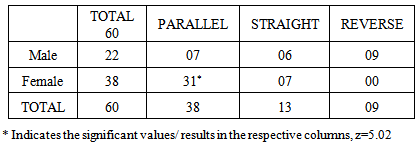 |
| |
|
Table 3. Position of Maxillary Incisor Curvature Related to Lower Lip
 |
| |
|
Table 4. Number of Teeth Displayed in Smile
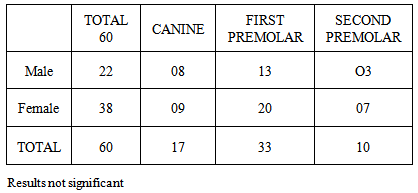 |
| |
|
 | Graph 1. Comparison of smile types |
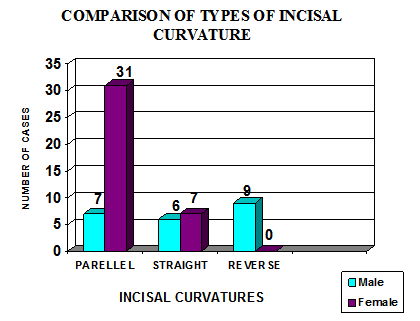 | Graph 2. Comparison of types of incisal curvature |
 | Graph 3. Position of maxillary incisors related to the lower lip |
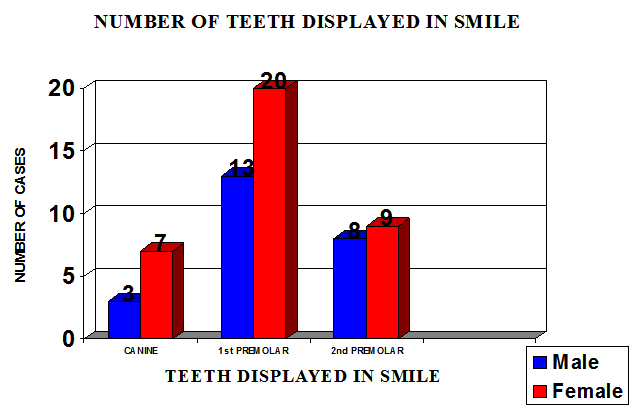 | Graph 4. Number of teeth displayed in smile |
Smile type: The study showed that 20% (12 subjects) showed high smile line (figure 3); 41.6% (25 subjects) showed average smile type (figure 2), and 38.3% (23 subjects) showed low smile type (figure 1). The average smile type showed a statistically significant occurrence in females. (z = 2.44)Type of maxillary incisal curvature: 63.3% (38 subjects) showed parallelism of incisal curvature with lower lip (figure 4); 21.6% (13 subjects) showed a straight upper incisal curvature (figure 5) and 15% (9 subjects) showed a reverse incisal curvature (figure 6).Parallel incisal curvature was significantly higher in females (z = 5.02) and reverse curvature was highly significant in males (reverse smile seen only in males in the present study).Position of the upper incisal curve in relation to lower lip: The upper incisor curvature touched the lower lip in 41.66% (25 subjects) (figure 7). The curvature did not touch the lower lip in 35% (21) cases (figure 8) and the incisal curve was covered by the lower lip in 23.3% (14) cases (figure 9).Females showed more of touching type of incisal curvature (z = 5.85) while males showed more of an incisal curvature that was not touching the lower lip (z = 2.81).The number of teeth displayed in a smile: Six anteriors were displayed in only 16.66% (10) cases (figure 12), six anteriors and first premolars in 55% (33) cases(figure 10), while six anteriors and both, first and second premolars in 28.33% (17) cases (figure 11). Differences in males and females in this group were not statistically significant. Also, there was no subject found in the study, with molars displayed in their smile.The result showed that the characters of an esthetic smile (figure 13)are: -− Average smile line, therefore only part of interdental gingiva seen.− Incisal curvature of maxillary anterior teeth parallel to the lower lip curvature. − Upper incisal curvature slightly touching the lower lip− First or second premolars also seen in smile.− A harmonious midline.All the above criteria were found more in females than males.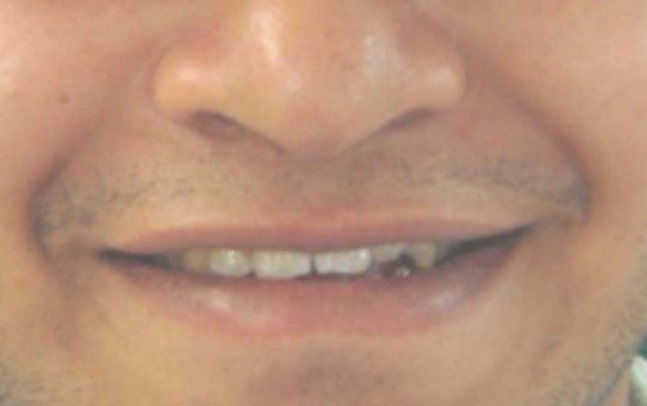 | Figure 1. Low smile line |
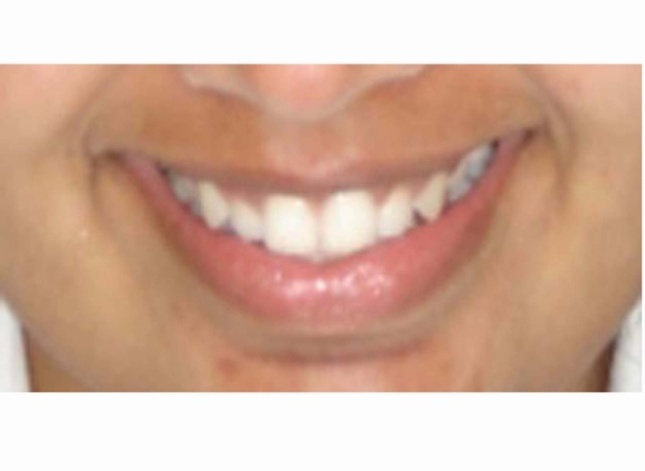 | Figure 2. Average smile line |
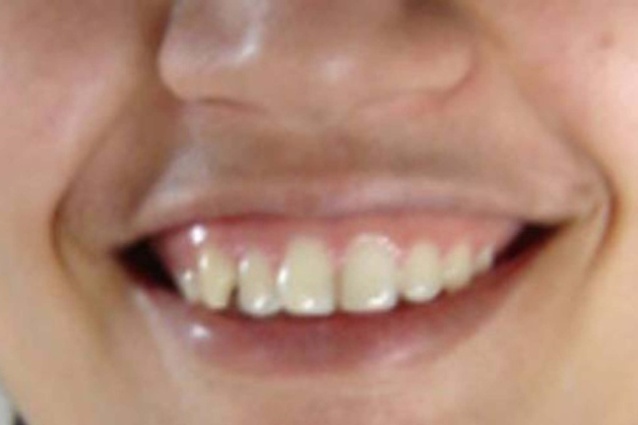 | Figure 3. High smile line |
 | Figure 4. Upper incisal curvature parallel to the lower lip |
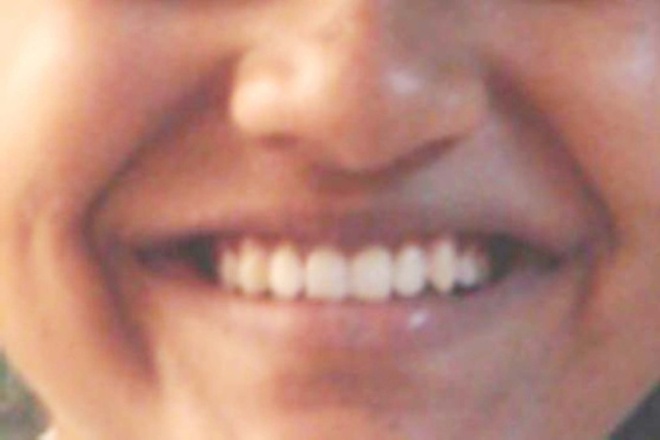 | Figure 5. Straight upper incisal line |
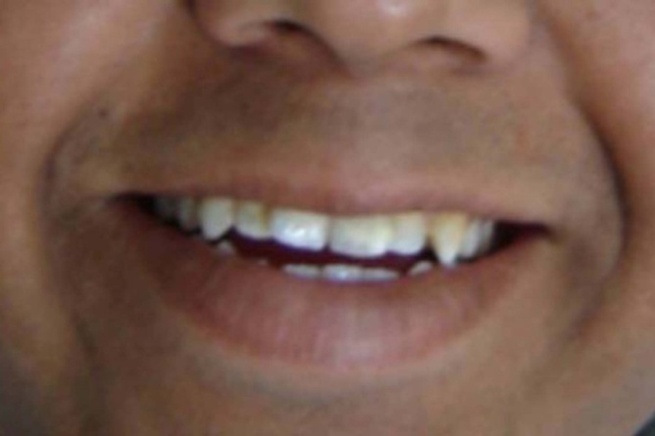 | Figure 6. Reverse smile line |
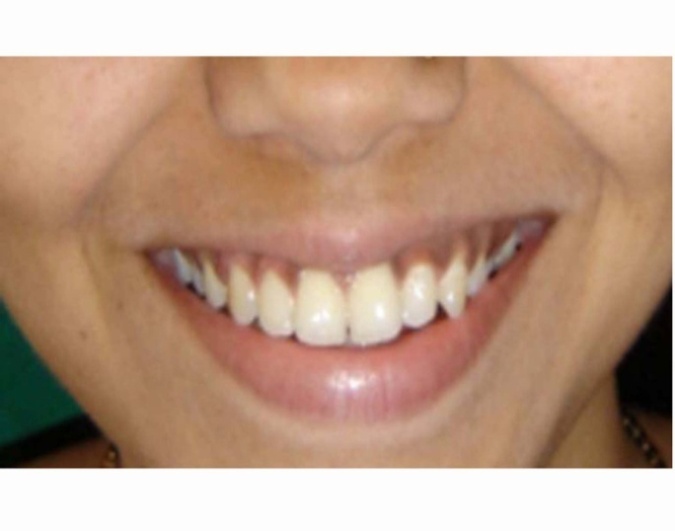 | Figure 7. Maxillary anterior teeth touching the lower lip |
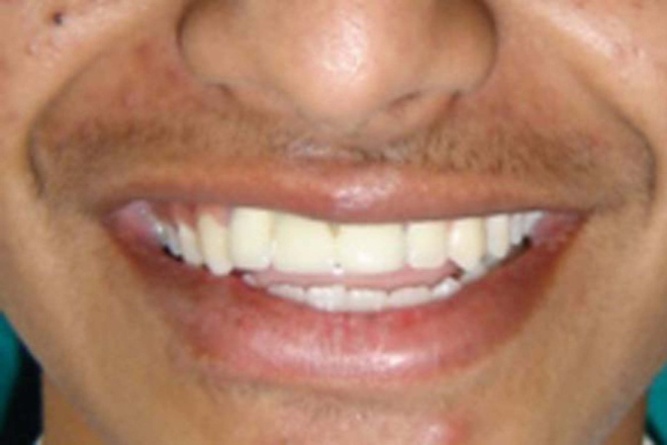 | Figure 8. Maxillary anterior teeth not touching the lower lip |
 | Figure 9. Maxillary anterior teeth covered by the lower lip |
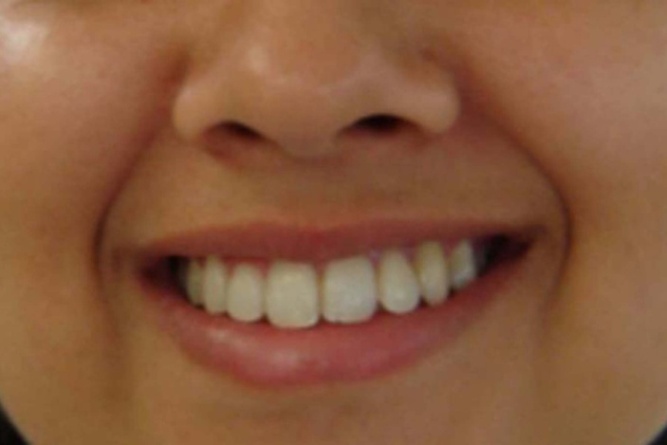 | Figure 10. Teeth upto I premolar displayed in smile |
 | Figure 11. Teeth upto II premolar displayed in smile |
 | Figure 12. Teeth upto canine displayed in smile |
 | Figure 13. Esthetic smile |
 | Figure 14. Unesthetic smile |
4. Discussion
The results obtained from the study may be very useful in improving the esthetics of the smile.The most frequently found characters in the smile were: average smile type (females), parallel incisal curvature (females), upper incisal curvature touching the lower lip (females) and smile exposing teeth up to first premolars; while the least found characters were: high smile type (females), reverse incisal curvature (males), upper incisor curvature covered by lower lips (females) and only canines seen in the smile.The most ESTHETIC characters found in the smile were (figure 13):Average smile type (females), parallel incisal curvature (females), upper incisal curvature touching lower lip (females) and premolars seen in the smile, while theleast esthetic characters (figure 14) were: low smile type (males), reverse incisal curvature (males), upper incisal curvature covered by the lower lip (females) and canines being exposed only.All these findings were statistically significant and also in accordance with earlier studies.However, while earlier studies [1, 3, 4, 11, 16, 21, 22] evaluated the characters of an average smile, this study additionally evaluated the characters of both- esthetic & unesthetic smiles.The parallel incisor curvature was highly significant (z = 5.02) in females, unlike earlier studies (where no significant difference in sex was seen). Also, the upper incisal curvature touching lower lip, found more in females was significant (z = 5.85) unlike earlier studies (where no significant sex difference was found).Along with these basic characters, other important criteria which should be considered while doing esthetic treatment planning are midline [21] (most important factor in an esthetic smile), occlusal plane, symmetry, lip length, thickness and buccal corridor [17] interdental papilla [14], negative space [5], buccal corridor [5, 15], incisal edge position, smile width, incisal curve [6], proportion of the teeth exposed [22] in the smile and gingival esthetics.The combination of all these factors is necessary to give an esthetic smile.
5. Conclusions
The characters of an average esthetic smile are:− Average smile type− Parallel incisal curvature− Incisal curvature touching the lower lip − Premolars seen in the smileThese criteria should be considered to improve esthetics of a smile, but at the same time, it should not be forgotten that it’s the patient who will decide as to what he/she considers as ‘attractive’. So, patient’s motive for seeking esthetic treatment should be examined first, lest most esthetic of characters would NEVER please them!!!...This study may be considered as a pilot study and a more extensive study with a larger sample size can be undertaken to have better results and more acceptable clinical values.
References
| [1] | Abdul–haqA, Suliman and Rawhi H Al Quasi, smile perception in dentistry. Cairo dental journal. (1) 53:60, Jan 2009. |
| [2] | Al – Habahbeh R, al-shammount R, Al- Jabrah O, Al- Omari F.: the effect of tooth and gender on tooth display in the anterior region during rest and smiling. Eur J Esthet. Dent 2009: 43:82-95 |
| [3] | Dong J K, Jin T H, Cho H W, OH Se. The esthetics of the smile: A review of some recent studies. Int. J Prosthodont 1999;12:9-19. |
| [4] | Dunn W J, Murchinson D F, Broome J C. Esthetics: Patients’ perception of dental attractiveness. J. Prosthodont. 1996;5:166-171. |
| [5] | Frush J O, Fisher R D. The dynesthetic interpretation of the dentogenic concept. J Prosthet dent. 1958;8:558 |
| [6] | Fradeani M. evaluation of dentolabial parameters as part of a comprehensive esthetic analysis.: Eur J Esthet Dent 2006 ;1:62-9 |
| [7] | Goldsein R E. Change your smile. 3rd edition. Carol stream (III): Quintessence publishing; 1997. |
| [8] | Husley C M. An esthetic evaluation of lip-teeth relationships present in the smile. Am J Orthod 1970;57(2): 132-144. |
| [9] | Levin E I. Dental esthetics and the golden proportion. J Prosthet Dent. 1978;40: 244-252. |
| [10] | Margolis M J. Esthetic considerations in orthodontic treatment of adults. Dent Cli North Am 1997; 41:29-48. |
| [11] | Matthews T J. The anatomy of a smile. J Prosthet Dent. 1978;39:128-134. |
| [12] | Mohan Bhuvaneshwaran. Principles of smile design.J conserve. Dent13.(4);oct-dec 2010 |
| [13] | Morley J, Eubank J. Macroesthetic elements of smile design. J Am Dent assoc. 2001 Jan; 132 (1): 39-45 |
| [14] | Morley J. The role of cosmetic dentistry in restoring a youthful appearance. J Am Dent Assoc 1999;130:1166-1172. |
| [15] | Parekh S M, Fields H W, Beck M, Rosensteil S. Attractiveness of variations in the smile arc and buccal corridorr space as judged by orthodontists and laymen. Angle Orthod 2006; 76(4): 557-563. |
| [16] | Peck S, Peck L. Selected aspects of the art and science of facial esthetics. Semin Orthod 1995;1:105-126. |
| [17] | Sachdeva k, single A , Mahajan V, Jaj HS , Negi A. Esthetic and smile characteristics at rest and during smiling. J Ind Ortho Soc 2012; 46(1): 17-25. |
| [18] | Sarver D M, Proffit W R, Dikson S. The dynamics of the maxillary incisor and the upper lip- a cross sectional study of resting and smile hard and soft tissue characteristics. World J Orthod. 2001. |
| [19] | Sarver D M. Esthetic Orthodontics and orthognathic surgery. St. Louis: Mosby; 1997. |
| [20] | Sarver D M. The importance of incisor positioning in the esthetic smile: the smile arc. Am J Orthod Dentofacial Orthop. 2001;120:98-111. |
| [21] | Tjan A H L, Miller G D, Josephine G P. Some esthetic factors in a smile. J Prosthet Dent. 1984; 51: 24-28. |
| [22] | Vig R G, Brundo G C. The kinetics of anterior tooth display. J Prosthet Dent.1978;39: 502-504. |



















 Abstract
Abstract Reference
Reference Full-Text PDF
Full-Text PDF Full-text HTML
Full-text HTML


